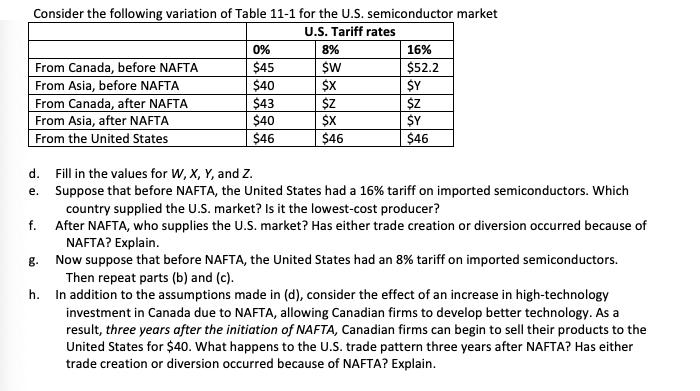Answered step by step
Verified Expert Solution
Question
1 Approved Answer
Consider the following variation of Table 11-1 for the U.S. semiconductor market U.S. Tariff rates From Canada, before NAFTA From Asia, before NAFTA From

Consider the following variation of Table 11-1 for the U.S. semiconductor market U.S. Tariff rates From Canada, before NAFTA From Asia, before NAFTA From Canada, after NAFTA From Asia, after NAFTA From the United States f. 0% $45 g. $40 $43 $40 $46 8% $W $X $Z $X $46 16% $52.2 d. Fill in the values for W, X, Y, and Z. e. Suppose that before NAFTA, the United States had a 16% tariff on imported semiconductors. Which country supplied the U.S. market? Is it the lowest-cost producer? After NAFTA, who supplies the U.S. market? Has either trade creation or diversion occurred because of NAFTA? Explain. Now suppose that before NAFTA, the United States had an 8% tariff on imported semiconductors. Then repeat parts (b) and (c). h. In addition to the assumptions made in (d), consider the effect of an increase in high-technology investment in Canada due to NAFTA, allowing Canadian firms to develop better technology. As a result, three years after the initiation of NAFTA, Canadian firms can begin to sell their products to the United States for $40. What happens to the U.S. trade pattern three years after NAFTA? Has either trade creation or diversion occurred because of NAFTA? Explain. $Y $Z $Y $46
Step by Step Solution
★★★★★
3.45 Rating (177 Votes )
There are 3 Steps involved in it
Step: 1
d To fill in the values for W X Y and Z we need to consider the given information and make assumptions based on the provided tariff rates From Canada before NAFTA 45 From Asia before NAFTA 40 From Can...
Get Instant Access to Expert-Tailored Solutions
See step-by-step solutions with expert insights and AI powered tools for academic success
Step: 2

Step: 3

Ace Your Homework with AI
Get the answers you need in no time with our AI-driven, step-by-step assistance
Get Started


